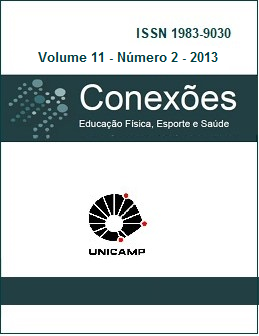Abstract
This study aimed to know who the Parana state tennis coaches are, how they made their way
until they began their careers and they turned into professionals. In order to collect this
information, at first a survey was made and validated, and it was made specifically for this
purpose. Took part in this sample 58 coaches with average age 32,5±9,9 years old. For the
data analyses was used the software SPSS 20.0. Having access to this data, it was possible to
verify that the class of the Parana State tennis coaches, mostly, is composed of men who
began their careers around the age 19,1±4 years old, after having worked catching the balls. In
general, these coaches show a good technical level being classified as 1st or 2nd classes in the
ranking of FPT. The most reported to be attending or have been majored in Physical Education Major, shown a great interest in the continuing training, provided by the massive
presence in training courses offered by CBT and wishing to take part in the postgraduate
courses in the sport. The initial and continuing training of the trainers has shown to be
influencing in a significant way the income these professionals earn, being more decisive than
the game technical level that was shown.
References
DELOITTE, T. T. Muito além do futebol: estudo sobre esporte no Brasil, 2011. Disponível em: http://www.deloitte.com/assets/Dcom-Brazil/Local%20Assets/Documents/Estudos%20e%20pesquisas/PesquisaMuitoAlemFutebol.pdf. Acesso em: 12 mar. 2012.
CONFEDERAÇÃO BRASILEIRA DE RUGBY. Disponível em: http://www.brasilrugby.com.br/. Acesso em: 3 maio 2012.
CAMPEIZ, J. M.; OLIVEIRA, P. R.; MAIA, G. B. M. Análise de variáveis aeróbias e antropométricas de futebolistas profissionais, juniores e juvenis. Conexões: revista da Faculdade de Educação Física da UNICAMP, Campinas, v. 2, n.1, 2004.
LÉGER, L. A.; LAMBERT, J. A maximal multistage 20-m shuttle run test to predict V02max. European Journal of Applied Physiology, Heidelberger, v. 49, 1982.
COOPER, K. H. A means of assessing maximal oxygen uptake. Journal of the American Medical Association, Chicago, v. 203, p. 201-204, 1968.
PITANGA, F. J. G. Testes, medidas e avaliação em educação física e esportes. 5. ed. São Paulo: Phorte, 2008.
JOHNSON, B. L.; NELSON, J. K. Practical Measurements for evaluation in physical education. Minessota: Burges, 1979.
FALK, P. R. A.; PEREIRA, D. P. Utilização do teste de 50 metros na mensuração da velocidade em adolescentes de Lages/SC. Publicado em 31 de março de 2009. Disponível em: http://www.webartigos.com/artigos/utilizacao-do-teste-de-50-metros-na-mensuracao-da-velocidade-em-adolescentes-de-lages-sc/16185/. Acesso em: 1 jul. 2012.
MATSUDO, V. K. R. Testes em ciências do esporte. 4. ed. São Caetano do Sul: CELAFISCS, 1987.
BOMPA, T. Periodização: teoria e metodologia do treinamento. 4. ed. São Paulo: Phorte, 2002.
VAZ, L. M. T. Perfil morfo-funcional dos jogadores de rugby juniores (Avançados/ Linha Atrasada). Disponível em: http://www.efdeportes.com/efd40/rugby.htm. Revista Digital, Buenos Aires, ano 7, n. 40, sept. 2001. Acesso em: 3 jul. 2012.
RAMSBOTTOM, R.; BREWER, J.; WILLIAMS, C. A progressive shuttle run test to estimate maximal oxygen uptake. British Journal of Sports Medicine, Loughboroug, v. 22, p. 141-144, 1988.
POLLOCK, M. L.; WILMORE, J. H. Exercícios na saúde e na doença: avaliação e prescrição para reabilitação. 2. ed. Rio de Janeiro: MEDSI, 1993.
AVELAR, A. et al. Perfil antropométrico e de desempenho motor de atletas paranaenses de futsal de elite. Revista Brasileira de Cineantropometria e Desempenho Humano, Florianópolis, v. 10, n. 1, p. 76-80. 2008.
LEVANDOSKI, G. et al. Composição corporal e aptidão física de atletas de handebol masculino campeões dos XXII jogos estudantis municipais da cidade de Ponta Grossa. Publicatio UEPG: ciências biológicas e da saúde, Ponta Grossa, 14, jul. 2009. Disponível em: http://www.revistas2.uepg.br/index.php/biologica/article/view/483/484. Acesso em: 01 jul. 2012.
BRAY, G. A.; GRAY, D. S. Obesity: pathogenesis. Western Journal of Medicine, San Francisco, v.149, p. 429-441, 1988.
BARROW et. al. Medidas e avaliação em educação física e esportes. 5. ed. Barueri: Manole, 2003.
LEAN, M. E. J.; HAN, T. S. Waist circumference as a measure for indicating need for weight management. British Medical Journal, London, v. 311, n. p. 158, 1995.
NATIONAL HEART, LUNG AND BLOOD INSTITUTE. Clinical guidelines on the identification, evaluation, and treatment of overweight and obesity in adults, Washington: National Institutes of Health, 1998.
AMER, N. M. et al. Índice de massa corporal e razão cintura/quadril de praticantes de atividade aeróbica moderada. Revista da Educação Física/UEM, Maringá, v. 12, n. 2, p. 97-103, 2001.
The Conexões: Educação Física, Esporte e Saúde Journal uses the license of Creative Commons (CC), thus preserving the integrity of articles in an open access environment.


